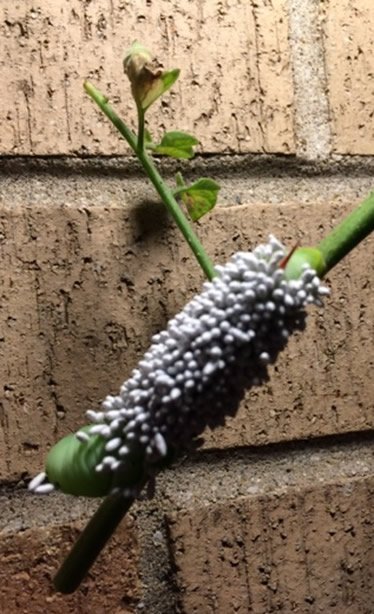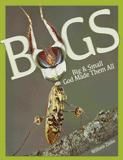
Parasitoid Wasps Shed Light on the Origin of Venom
News to Know
Abstract
Parasitoid wasps’ venoms transform their victims into zombies inside and out.
News Source
- Quanta: “Moonlighting Genes Evolve for a Venomous Job”
- ASBMB: “Serpins in Wasp Venom Block Host Immune Response”
At-a-Glance
- Parasitoid wasp larvae feast upon arthropod larvae as they grow.
- Parasitoid wasps inject arthropod victims with venom and their eggs.
- Parasitoid wasp venom affects the immune system and behavior of larval hosts.
- Parasitoid wasp genes do double duty to manufacture a variety of zombie-producing venoms.
- Many components of wasp venom are produced by genes having other uses in the wasp’s body. This illustrates one way defense-and-attack structures developed after sin entered the perfect world God made.
Providing food for one’s younglings is perhaps a mother’s most basic job, even for a mother wasp. Parasitoid wasps do this in a rather gruesome way. They lay their eggs in or on another arthropod, like a caterpillar, cockroach, or spider. When the eggs hatch, their parasitic larvae slowly consume the victim’s body, deriving nourishment and protection until they are ready to go forth into the world as adult wasps.
Parasitoid wasps are a diverse and abundant component of agricultural ecosystems. They are only parasitic while in their larval stage. While some parasitoid wasps target invertebrates that we humans “like,” the majority of the estimated 600,000 species prey upon pests that attack our food crops, making them our allies despite their ghoulish habits.


This is the tomato hornworm—which can quickly destroy an entire tomato plant. But this tomato hornworm is carrying braconid wasp larvae. When the eggs laid on the hornworm hatch, they feed on the pesky caterpillar’s insides. Braconid wasps1 can inject their victims with venomous compounds and endosymbiotic viral DNA that suppress the victim’s immune system, render it docile, and—if it survives—make it infertile. If you find the hornworms in your garden so adorned, you should probably leave them alone, knowing that the tomatoes you lose today will indirectly nourish an up-and-coming population of pest-destroying parasitoid wasps. You can even attract more of these wasps to your garden by planting parsley, dill, and mustard nearby, as the wasps are attracted to their nectar.2 Images by Frost Smith.
Many parasitoid wasps optimize the reception for their larvae by injecting venom that disables the host insect’s immune system or changes its behavior. Some of these venoms render the parasitized creature a docile victim. Some even trigger actions directly helpful to the parasites, such as the victim actively protecting them or building them a sturdy cradle or nest. (Check out “Fear the Parasitic Wasp: Spider Zombies Caught in Web of Deceit.”)
Venomous Arsenals of Doom
Venom is produced by many sorts of animals, such as bees, snakes, scorpions, fangblennies, cone snails, and lionfish. Venoms, in general, are a cocktail of biomolecules, many of which have other nontoxic physiologic functions. And venom toxins may affect victims in various ways—causing pain or blunting it, inhibiting or stimulating blood coagulation, paralyzing or overstimulating nerves, drastically dropping blood pressure, dramatically lowering blood sugar, or impairing muscular control. Many venoms sting, disorient, disable, paralyze, or kill, but parasitoid wasp venom must leave its victim alive and functional if it is to serve its purpose of serving up a healthy meal-on-the-hoof (so to speak) for its yet unhatched larvae.
Many components of snake venom are encoded by genes that appear to be altered copies of genes that produce nontoxic physiologically active compounds used elsewhere in the animal’s body.
Evolutionary biologists have long thought that venoms evolved primarily through the mutation and repurposing of duplicated genes. This model developed after the discovery that many components of snake venom are encoded by genes that appear to be altered copies of genes that produce nontoxic physiologically active compounds used elsewhere in the animal’s body. This discovery was no surprise from a biblical creationist’s perspective.
When God created all kinds of animals and plants in a perfect world about 6,000 years ago, he created them to reproduce after their kinds and provided them with the genetic diversity and potential to vary. After Adam’s sin brought death’s curse upon all of creation, many defensive and offensive traits developed. In the case of snake venom, the discovery that analogs of physiologically important substances could be expressed in toxic roles demonstrated that new genetic information was not needed in order for these animals to develop venomous adaptations after Adam’s Fall and its Curse upon the world.
Smorgasbord of Venom
University of Rochester biologist John Werren studies parasitoid wasps. His team reports it has not only learned a lot about how the venomous constituents work but also discovered some startling facts about their genetic and evolutionary underpinnings. While they actually reveal nothing to support the claims of molecules-to-man evolution, Werren’s game-changing discoveries do shed light on just how the parasitoid wasps stock their surprisingly diverse arsenals of doom.
Unlike the death-dealing venom produced by some animals, the venoms produced by parasitoid wasps must not only leave their victims alive but also manipulate their metabolism or behavior in some useful way. Parasitoid wasp venom is most effective if it prevents the victim’s immune system from attacking the larvae left in its “care” and triggers some sort of behavior that will protect the yet-unhatched larvae. There’s a lot more involved in victimizing a caterpillar long enough to raise a “litter” of larvae than just turning it into a willing zombie.
One protein Werrin’s team identified, for instance, is an antifungal agent, so it presumably keeps the larvae’s living dinner from becoming moldy. Earlier this year a group of Chinese researchers led by Gong-yin Ye at Zhejiang University’s Institute of Insect Science found that some parasitoid wasp venom specifically inhibits melanization, an important type of insect immunity. Many insects fight invaders by producing melanin to encapsulate them. The process of producing this melanin also generates oxidizing enzymes toxic to invaders.3 Ye’s team found that a serpin compound produced by an agriculturally helpful wasp inhibits an enzymatic step in this process.
Furthermore, some parasitoid wasps target only very specific victims. And the venoms of parasitoid wasps exhibit a surprising degree of variety. The enormous variety of venoms used by parasitoid wasp species raises many questions about the origin of venom in general and these target-tailored variations in particular.
Genetic Underpinnings of Parasitoid Wasp Venoms
The menu for parasitoid wasp venoms contains a bewildering array of compounds. And there is remarkable diversity of venoms across the many parasitoid wasp species. Each venomous substance must of course be encoded in the wasp’s DNA. The genes for the venom proteins are then expressed by the wasp’s venom glands.
Werren’s team found that even genetically similar wasps share only a fraction of the genes they use to make their venom. And it appears that across wasp species there is rapid turnover of the genes serving as venom makers, keeping the wasps ahead of their victims in an arms race for survival. Being able to readily recruit genes for venom production makes it possible for a wasp species to zero in on whichever host-target species are readily available. Where do these venom genes come from?
To find out more, Werren’s team zoomed in on four particular parasitoid wasp species. While thought to be closely related based on genetic similarities, these species differ greatly in their target host selection. One victimizes a wide range of insect pupae—flies, beetles, and butterflies—while the others focus their attentions on particular sorts of flies. One of the studied species confines its envenoming ministrations to only one sort of fly.4
Over half of the genes expressed by wasp venom glands to make venom components are single copy genes, not duplicates of other genes in the wasp genome.
The wasp venom gland efficiently expresses the genes for the substances it includes in its venom. Werren’s team analyzed the components of each wasp’s venom. They identified 406 different venom proteins in the four wasp species they studied. Then they looked for the matching genes. The species with the broadest range of targets expressed the greatest number of venom genes (134) and the most highly specialized wasp they studied expressed the fewest venom genes (78).5 They were surprised that even species that are otherwise very similar genetically produce very different venomous cocktails. And most surprising of all, though popular snake-based wisdom suggests that venom-making genes are mutated duplicates of other genes, over half of the genes expressed by wasp venom glands to make venom components are single copy genes, not duplicates of other genes in the wasp genome.
Moonlighting Genes
These single-copy “venom genes” are not just used for venom production in the parasitoid wasps Werren’s team studied. “When we first started doing this, we were actually looking at this all wrong,” Werren explains. “We thought that what we were seeing was the rapid specialization of genes as venoms, and loss of their other function.”6 But that wasn’t the case. Instead, like a person who moonlights while keeping his day job, these genes—expressed in different tissues—serve multiple roles in the wasp’s body. When expressed by venom glands, the genes supply the ammunition for the parasitoid wasp’s version of motherhood. “That’s why a lot of this is expression evolution,” Werren says. “The protein isn’t changing much. It’s just its expression pattern that’s changing to make it a venom.”7
The prevalence of the parasitoid wasp venom production model in other sorts of venomous animals remains to be determined. “It had not particularly occurred to me as a likely mechanism of venom evolution,” says Bangor University’s Wolfgang Wüster, who is not convinced that this mechanism explains the genetic origin of venom in other sorts of animals. “As the authors point out,” he says, “parasitoid venoms act in a much subtler, more fine-tuned manner than the better known predatory or defensive venoms of things like snakes, spiders or cone shells. Extended anaesthesia is much more difficult and requires much more finesse than killing something—ask any surgeon.”8
Further research may reveal still more information about the genetic underpinnings of this and other defense and attack structures. But despite the convenient use of the word evolution in connection with this discovery, there is no molecules-to-man type evolution going on here. The genetic information to produce venomous substances already exists in these useful animals. “Expression evolution” is not a mechanism that could explain molecules-to-man evolution. It merely reflects the fact that the genes expressed by each species of wasp vary a lot, equipping each to parasitize its particular prey. Expression of that genetic information by the venom gland and the effectiveness of each venom in enhancing the reproductive success of each wasp species is doubtless a platform on which selection pressure can operate, producing many wasp-target pairings. Those parasitic partnerships enhance the agricultural potential in this sin-cursed world.
Sin, Suffering, Death, and Design
Nature is indeed “red in tooth and claw.” This phrase comes from Alfred Lord Tennyson’s elegy to his friend, “In Memoriam A. H. H., 1850.”9 In Canto 56 Tennyson describes what many people see as a conflict between the loving character we ascribe to God and the suffering in the world around us.
Charles Darwin was troubled by the specter of parasitoid wasps setting up their young to cannibalize living caterpillars. In an 1860 letter to his friend Asa Gray, Darwin wrote, “I cannot persuade myself that a beneficent and omnipotent God would have designedly created the Ichneumonidae10 with the express intention of their feeding within the living bodies of caterpillars.”11
God has left us a historical record that tells the truth about the origin of suffering and death.
We too might be tempted to question God’s goodness if we thought he created parasitoid wasps from the beginning to cannibalize unsuspecting caterpillars—at least if we are squeamish or personify the insects surrounding us. But God has left us a historical record that tells the truth about the origin of suffering and death. He isn’t to blame at all. He created all things perfect in the beginning, a world devoid of animal and human death and its attendant suffering. What happened?
Here’s a bulletin, right from the pages of God’s Word. We did it. Humans, that is. In our modern world it has become popular among some groups to blame all sorts of problems on the humans “infesting” earth. But the fact is that the earth was created by God, from the beginning, to be happily occupied by humans, beginning with Adam and Eve, who were charged with its care, not its corruption. Alas, Adam and Eve thought they had a better idea and rebelled against the loving rule of the Creator God. Choosing to violate the only rule he gave them, they thus declared they wanted to have it all their own way. The results were catastrophic. Nature became “red in tooth and claw.” Because of humanity’s fall into sin, both animals and humans suffer and die.
Yet even in the sin-cursed world that surrounds us, we can see the marvels of God’s design. That includes the delicate balance that has equipped these parasitoid wasps with the genetic information and adaptive mechanisms to specifically target, envenom, utilize, and destroy many of the varmints consuming our valuable food supplies. When we look at the parasitoid wasp and—perhaps like Darwin—shudder, let us be reminded not only of the real reason such things exist but also of the Creator God who made it possible that, even in a world cursed by sin and death, we have such unlikely allies in our efforts to feed the human population God created to inhabit the earth. (Isaiah 45:18).
Further Reading
- Fear the Parasitic Wasp: Spider Zombies Caught in Web of Deceit
- Mamba Venom Derives from Gene Duplication
- Scorpion Venom Is No Match for Mighty Mouse
- How the Scorpion Got Its Sting
- Did Spiders Evolve Knees Through Gene Duplication?
- Origin of Fangblenny Fish's Unusual Venom
For More Information: Get Answers
Remember, if you see a news story that might merit some attention, let us know about it! (Note: if the story originates from the Associated Press, FOX News, MSNBC, the New York Times, or another major national media outlet, we will most likely have already heard about it.) And thanks to all of our readers who have submitted great news tips to us. If you didn’t catch all the latest News to Know, why not take a look to see what you’ve missed?
(Please note that links will take you directly to the source. Answers in Genesis is not responsible for content on the websites to which we refer. For more information, please see our Privacy Policy.)
Footnotes
- Braconid wasps are a large family of parasitoid wasps.
- Kevin Lee Jacobs, “When Not to Kill a Tomato Hornworm,” A Garden for the House, August 4, 2011, http://www.agardenforthehouse.com/2011/08/when-not-to-kill-a-tomato-hornworm/.
- G. F. Rohrmann. “Host Resistance, Susceptibility and the Effect of Viral Infection on Host Molecular Biology, chap. 8 in Baculovirus Molecular Biology [Internet]. 3rd ed. Bethesda, MD: National Center for Biotechnology Information,, 2013.
- Ellen O. Martinson, Yogeshwar D. Mrinalini, Ching-Ho Chang Kelkar, John H. Werren, “The Evolution of Venom by Co-option of Single-Copy Genes,” Current Biology (July 10, 2017) 27: 2007–2013, https://www.ncbi.nlm.nih.gov/pubmed/28648823.
- Ibid.
- Christie Wilcox, “Moonlighting Genes Evolve for a Venomous Job,” Quanta, June 22, 2017, https://www.quantamagazine.org/moonlighting-genes-evolve-for-a-venomous-job-20170622/.
- Ibid.
- Ibid.
Tennyson wrote:
Who trusted God was love indeed
And love Creation’s final law
Tho’ Nature, red in tooth and claw
With ravine, shriek’d against his creed.- Ichneumonidae is a family of parasitoid wasps.
- Francis Darwin, ed., The Life and Letters of Charles Darwin, volume 2 (New York: Appleton, 1897), 105.
Recommended Resources

Answers in Genesis is an apologetics ministry, dedicated to helping Christians defend their faith and proclaim the good news of Jesus Christ.
- Customer Service 800.778.3390
- © 2024 Answers in Genesis


